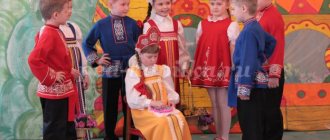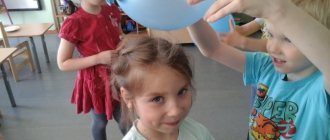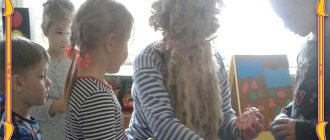Possibilities of theatrical activities for speech development
It is easy to imagine a theatrical performance and guess what its significance is in the development of the speech of the participants. The actors expressively and emotionally deliver monologues, conduct meaningful dialogues, demonstrate a rich vocabulary, are full of synonyms and epithets... Of course, this beautiful sound is preceded by numerous rehearsals.
But, if adults can polish their speech with the help of theatrical activities, then why not use elements of theatrical performance to develop the speech skills of children who are only at the first stages of speech development?
In fact, specialists and educators have long adopted elements of theatrical activities to develop the speech of preschoolers and primary schoolchildren.
Children's speech skills develop in theatrical play, in recitation, and when voicing dolls in small productions, which are quite accessible at preschool age.
By including the child in playing small scenes, or inviting him to play the role of a fairy-tale hero, adults create conditions for the development of the most important speech skills:
- Use ready-made speech patterns
- Practice pronunciation
- Competently construct sentences
- Formulate your thoughts logically
- Express yourself expressively
- Understand logical stress in phrases
Systematic classes with elements of theatrical performances, as well as theatrical games, have a significant impact on the development of speech in preschool children. Children learn to speak coherently, and the development of coherent speech in preschool children is the main goal that must be achieved in speech development.
MAGAZINE Preschooler.RF
Development of expressive speech through the use of various types of theatrical activitiesThe speech development of children is closely related to mental, moral, aesthetic development, and is a priority in language education and training of preschoolers. For the development of expressive speech, it is necessary to create conditions in which every child could convey his emotions, feelings, desires and views both in ordinary conversation and in public, without embarrassment to listeners. Theatrical activities provide great assistance in this, the educational possibilities of which can satisfy any interests and desires of the child. Children get acquainted with the world around them in all its diversity - through images, colors, sounds, music, and questions skillfully posed by the teacher encourage them to think, analyze, draw conclusions and generalizations. In the process of working on the expressiveness of characters’ remarks and their own statements, the child’s vocabulary is activated and the sound culture of speech is improved.
Correct determination of location on stage, dancing develops orientation, motor skills, and motor activity. When working with children in theatrical activities, special attention must be paid to interaction with the family. Parents provide assistance in making costumes and attributes. They purposefully visit theaters and museums together with their children, read works and watch videos recommended on the topic. This helps broaden one’s horizons, enriches the inner world, and most importantly, teaches family members mutual understanding, brings them closer, and is a means of developing general gaming skills, speech, the child’s personal qualities, and his adequate behavior in various situations. Theatrical play has a great influence on the child’s speech development, stimulates speech by expanding the vocabulary, and improves the articulatory apparatus. In theatrical play, dialogical, emotionally rich speech is formed. Children better understand the content of the work, logic and sequence of events. Theatrical activity promotes the assimilation of elements of verbal communication (facial expressions, gestures, posture, intonation, voice modulation). Theatrical activities include dramatization, plot sketches based on fairy tales, stories, and poems. With the help of theatrical activities, you can solve almost all problems of the speech development program. The mental state of some children does not always allow each child to fully realize their abilities; such children need special attention. First, children are read small texts, analyze the content, explain unclear words, discuss the actions of the characters, then divide the texts into episodes and retell the text (poems, songs, nursery rhymes, mini-scenes, fairy tales). The next stage of work is retelling by role. Children become participants in a small performance. Children were offered different types of theater based on the same work. During their work, teachers constantly monitor children’s speech – sound pronunciation, placement of words in sentences, pronunciation of case endings, and sequence of retelling. Children with disabilities must be given the opportunity to adapt, not be forced to participate in theatrical games, but invited, for example, to be given dolls to manipulate them freely. When working on the expressiveness of speech, it is very important to do articulatory gymnastics: 1. Brush your teeth, both upper and lower, with your tongue. 2.Close your eyes, imagine the night. We got on the horse and rode off. 3.Draw the sun with your eyes closed, etc. Since these exercises are carried out in a playful way, most children enjoy performing articulatory gymnastics. For the development of expressive speech, sketches that promote the creative development of children are very important. For example, the sketch “Loving Parents”: A lullaby sounds. Mommy bear and daddy bear are rocking their beloved son. First, the mother bear rocks the cub, gently hugging him to herself, and the father bear looks at mother and son with a kind smile and rocks himself too. Then mom hands her son over to dad. Expressive movements: fold your hands in front of you, clasping your fingers around the elbow of the other hand, swaying rhythmically to the music from right to left, with a smile on your face. Sketch “Grandma Got Sick.” It is very important to develop the hand motor skills necessary for free puppeteering. We offer the following exercises: 1. “Flag” (thumb extended upward, the rest are connected together) 2. “Birds” (thumb alternately connected with the rest) 3. “Nest” (join hands in the form of a bowl, fingers tightly clenched) 4. “Flowers” (the same, but separate the fingers) Speech development of children occurs in the process of individual work with children. This work helps in the future to take part in joint play, as the child feels more confident. At this time, we are noticing positive changes in the emotional development of children; interest in theatrical activities and independence have increased. When playing with children, we choose a calm, friendly tone, which helps to establish contact with the children, win them over, and make them feel self-confident. In any statement or part of it (sentence), the following components can be distinguished: logical stress, melody, tempo, rhythm, pause, timbre. It is very important to teach children to understand and correctly place logical stress in phrases. This is necessary in order to convey the meaning of your statements to other people more clearly and emotionally. One of the types of musical and playful creativity in theatrical activities - dramatization of songs - is very captivating for children. They quickly remember the words of all the characters, often improvise on their own, dressing up and acting out this or that scene. Children's speech becomes more expressive and literate. They begin to use new words, proverbs and sayings from the song repertoire, folk songs, jokes, and in everyday situations that coincide with their semantic content. The resulting positive emotional charge and acquired self-confidence increase children’s self-esteem. Children learn to think, analyze their behavior and the behavior of other people, and become more attentive and tolerant of each other. Their gaming activity intensifies, acquires a creative character and emotional intensity. Experience convinces us that the joint work of the music director and all teachers can lead to the desired result: it will solve many pedagogical problems related to the speech development of children. Together with teachers, I discuss certain problems in the speech development of children that arise in my work. Therefore, along with exercises to develop children’s musicality, I use a number of additional exercises that promote the development of phonemic hearing and attention, and the development of the vocal apparatus; rhythmic games with tasks for spatial orientation; exercises for distinguishing musical sounds by pitch, for adjusting voices to a specific musical sound; chants to automate the sounds that children learn in speech therapy classes. Effective interaction between teachers is the joint development and conduct of logorhythmic classes based on the connection between movement, music and words. For example, walking to different types of music: like wolves, like hedgehogs, like foxes. The children talked with the teacher about the characteristics of these animals, listened to music corresponding to the character of this character and independently performed movements with changing parts of the music. When talking with children about music, I activate in their dictionary such definitions as “music - calm, affectionate, sincere, inspired” or “music - perky, sparkling, joyful, playful.” By studying symphonic music, children become familiar with the sounds of various musical instruments and their names. For example, in rhythmic studies based on the musical fairy tale “Peter and the Wolf” by S. Prokofiev, children learned the names of musical instruments of a symphony orchestra - “flute”, “clarinet”, “oboe”, “bassoon”. Having difficulties with pronunciation, not all children can enrich their vocabulary with such complex words, but showing this musical instrument in an illustration, depicting it with the help of musical and playful creativity, using facial expressions, gestures, character and genre of music is not only possible, but also very interesting for children . Work on the development of speech in general, and on the development of intonation expressiveness in particular, is very difficult, but extremely necessary. And it’s easier and more interesting to carry it out, integrating it with theatrical activities. It is integration that allows the development of individual abilities and the formation of independent artistic and speech activity of children, the development of their creative abilities. Developing the creative abilities of children together with teachers, combining our efforts, we do not set the goal of making artists, performers or musicians out of them. But in their subsequent lives, the possibility of creative work will open before each of them. And it is very important that the child does not lose emotional responsiveness, admiration for beauty, and an aesthetic attitude towards the surrounding reality.
| Next > |
Forms of theatrical activity in children's speech practice
Parents are often wary of recommendations to use the possibilities of theatrical activities in the development of their child. First of all, adults are put off by the preparatory stage: creating the right atmosphere, preparing the necessary attributes. But to use theatrical methods it is not necessary to create a full-fledged home theater.
You can use both staging story scenes with appropriate props, or puppet theater, and simplified methods, which come down to expressive retelling and addition of well-known fairy tales and stories. A fairy tale is a truly effective teacher in a child’s life and can be actively used for speech development.
Telling tales with addition
The same favorite fairy tales and children's stories can simply be read to a child, but much more opportunities for development will open up if the child joins the story. Participation in storytelling (reading) of works for children can be considered the simplest type of theatrical activity.
An adult, as a rule, reads to a child with appropriate expressiveness, emphasizing characteristic roles with his voice and intonation. Listening to a story, a preschooler, thanks to visual imaginative thinking, builds a figurative series of plot. Adults sometimes don’t even realize how many interesting twists their young listeners can add to the storyline.
Moreover, the child strives to complement, imitating the style of the story. A literary text demonstrates to the child the grammatical structure of speech, develops sound culture, helps to feel the beauty of sound and the richness of language. And the preschooler tries to match so that his improvised inserts sound like that.
Sometimes the initiative to get involved in the plot comes from the child himself. But you shouldn’t wait for spontaneous activity. Adults can encourage the preschooler with appropriate questions. For example:
- What could our hero do?
- Why did the main character do such an act?
- Who else could come to the rescue?
In older preschool age, you can practice group writing of your own collective fairy tales. Each child will have to come up with a small part (2-3 sentences). This makes the task feasible even for those preschoolers who experience speech difficulties.
Children get the opportunity to hear how others formulate statements and reveal the plot, how intonation they try to emphasize the nature of the role or the tension of events. This serves as a powerful example for each participant and also develops auditory awareness.
Participation in a theatrical performance of the plot
Theater productions require at least a minimal costume. And in preschool age, any attribute helps to get into the role. Notice how much better a child will portray a bunny if he wears a hat with bunny ears and a tail...
Playing a role imposes important obligations on the child. He should not say what he wants, but what is provided for in the plot in advance or what corresponds to the unfolding of actions, if improvisation takes place.
In such conditions, speaking is both more difficult and easier at the same time. It’s more difficult because you need to formulate phrases that reflect the content and select the appropriate words. If this is a monologue, then it must be coherent so that others understand the meaning of the message. It’s easier because there is a ready-made text that has been told and retold many times. This means that many phrases are reproduced automatically by the baby.
Thanks to learning and performing the role, the little artist’s vocabulary is enriched and the expressiveness of speech develops. The child strives to convey the intonation that matches his character and tries to make semantic accents.





